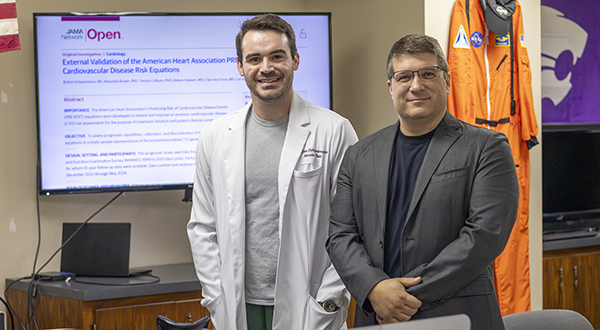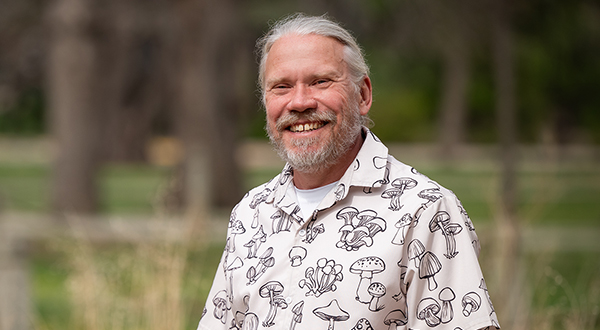A university for the universe
K-State's space research is taking us to and through the stars
n the cosmic heavens humanity finds some of its most considerable challenges in questions of time, distance and resources needed to explore and understand the universe.
Yet in these difficulties, humankind also finds its biggest opportunities to reach to and through the stars, and Kansas State University is meeting those obstacles head on.
K-State researchers choose these challenges not because they are easy, but because they define the excellence expected and demanded of a next-generation land-grant university — by Kansans, for Kansans and for the world.
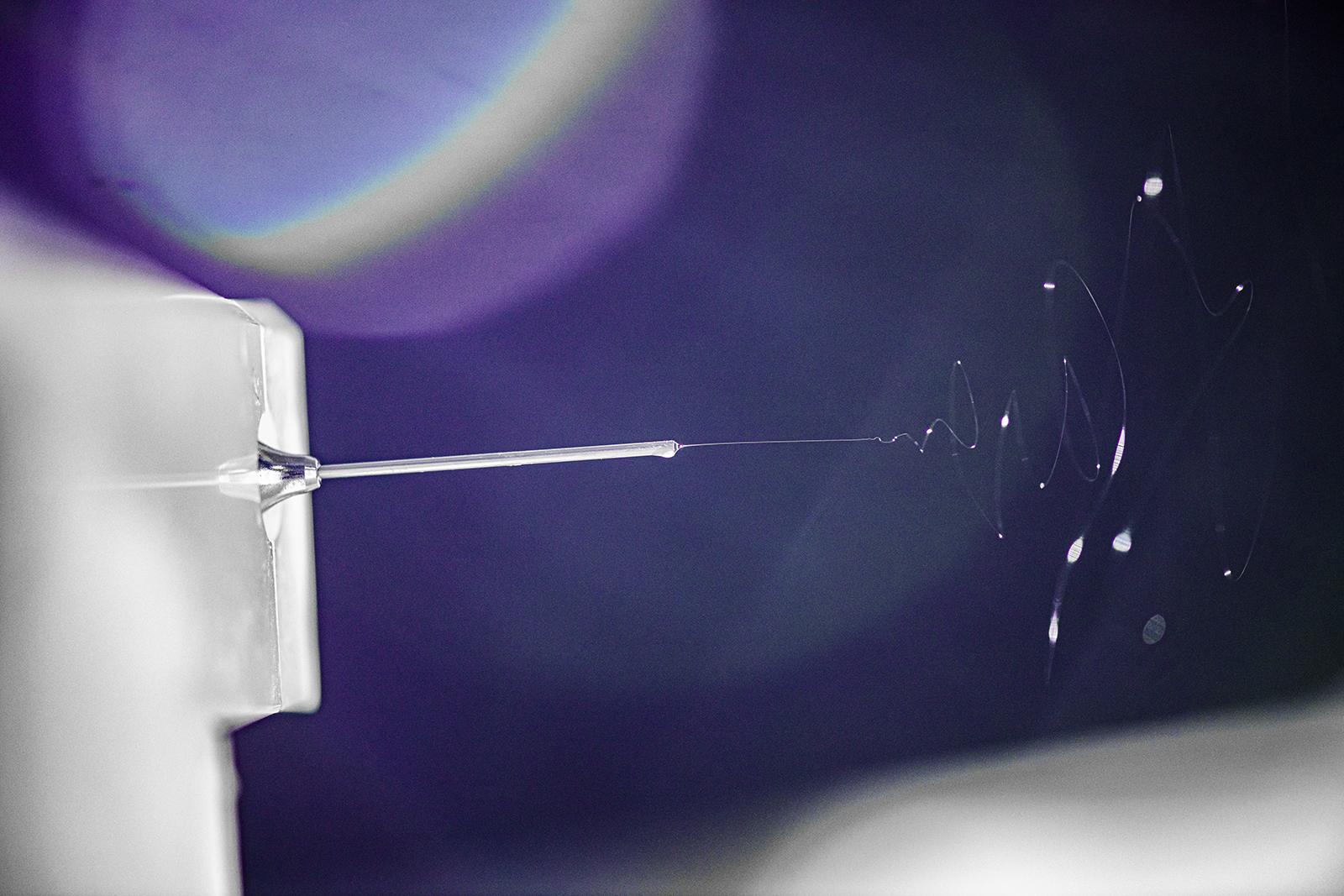
Jun Li, university distinguished professor of chemistry, is researching the potential use of electrospinning — a process in which a tiny needle shoots an extremely thin strand of a viscous polymer solution, guided by strong electrostatic forces, to weave a web of fibers — as a way to 3D print filters in space.
Electrospinning in space
The terrible irony of space exploration is that for all the vast and almost limitless potential of worlds beyond our own, humankind is still limited by the relatively few resources it can send into space from Earth.
Every ounce of material launched into space costs tens of thousands of dollars in rocket fuel. Despite that, many of the mission-critical instruments and equipment require backups to be launched alongside them, which skyrockets the cost of missions.
But what if astronauts could create those items in space, as needed?
Jun Li, a university distinguished professor of chemistry in K-State's College of Arts and Sciences and former NASA physical scientist, and researchers from the University of Kansas and Wichita State University are using a $750,000 NASA award to study the potential of in-space electrospinning manufacturing.
Over the past decade, NASA has experimented with traditional 3D-printing techniques in space, which typically work by setting down several layers of a given material over each other. But while these techniques work for certain uses, the lack of gravity in space often leads to brittle, low-density items.
Electrospinning, on the other hand, works by shooting out extremely thin strands of a material — in this case a viscous polymer solution — guided by strong electrostatic forces to essentially weave a web, or membrane, of fibers between 100 and 500 nanometers in diameter. The tiny gaps between the fibers can act as a type of screen to let through smaller particles while blocking bigger ones. The high surface area also enhances the capture of specific toxic chemicals.
The best application for these membranes right now is as filters, such as for cleaning air or water. Such filters are also useful for tackling one of the biggest challenges to human and technology survival in space and on other planets: dust.
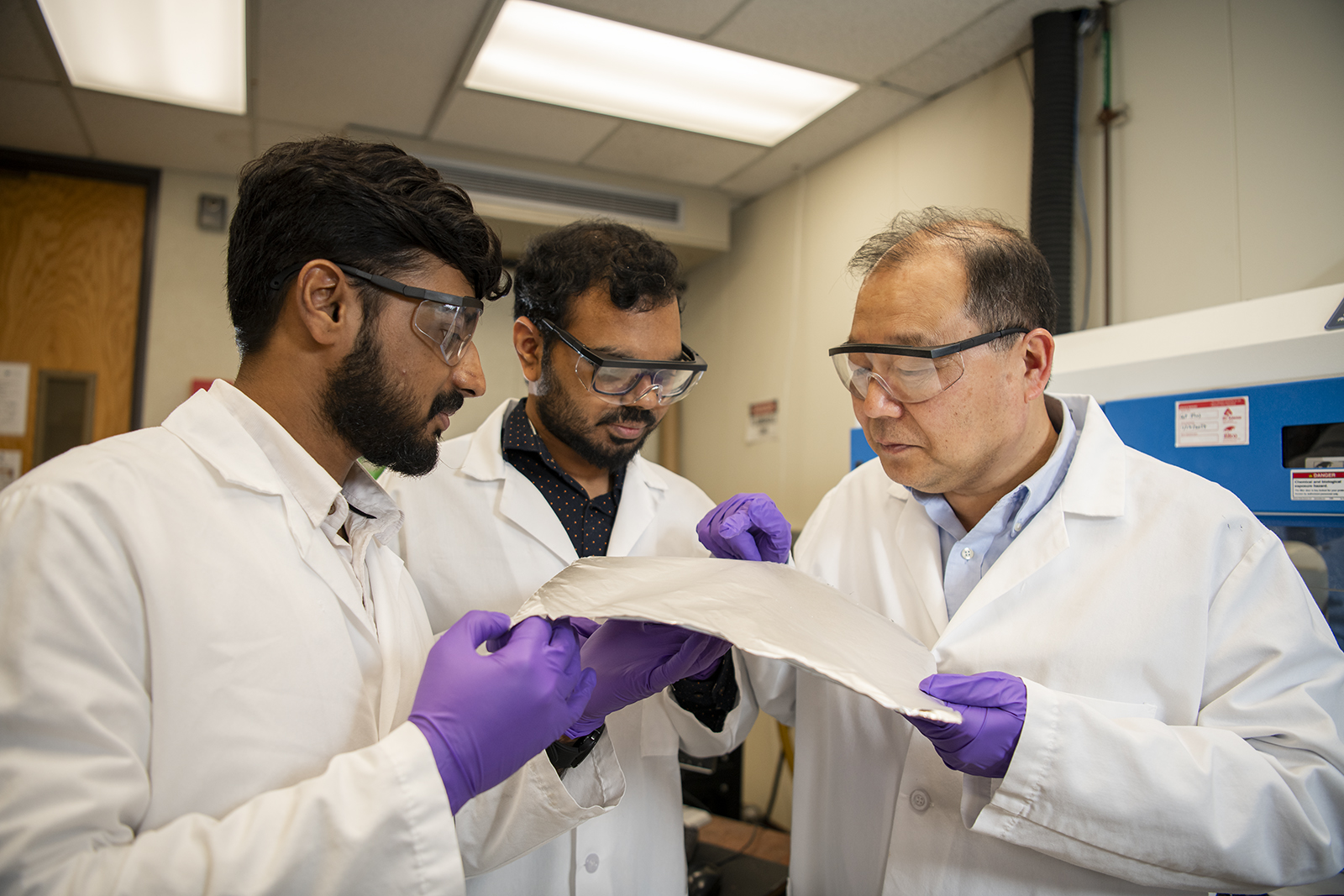
Jun Li, right, works with graduate students in his laboratory to examine a nanofiber membrane created through the electrospinning process.
“On Earth, dust particles eventually fall to the ground because of gravity, but in space they remain floating around,” Li said. “If you landed on the moon or Mars, the surface is covered in dust, and if you’re walking around, you generate dust. As an astronaut, that doesn’t interfere too much with your ability to breathe since you’re wearing a mask with its own oxygen supply. But you don’t want your specialized instruments exposed to the dust, particularly those tiny ones at nanoscales.”
As part of the NASA award, the researchers are fabricating nanofiber membranes in Li’s laboratory at K-State, testing physical properties at the University of Kansas and assessing and optimizing the manufacturing technique at Wichita State University.
The research group also works with NASA research centers, national laboratories and private industry partners to explore other ways to use the electrospinning technique, including by integrating artificial intelligence in the manufacturing process as well as recycling previously created material.
Other potential applications could include the creation of sensors, actuators and solid-state batteries, which need thin layers of material as transducers or membranes to separate the electrodes that react to release energy.
Li imagines that such work could one day pave the way for directly making use of lunar and Martian dusts — or dust from any other celestial body we visit — to produce items using electrospinning.
“In principle, this is a low-cost technique,” Li said. “You really just need to bring some material, in this case a polymer, and some solvent. Then you just decide if you want to use it as an air filter or potentially as a component for a battery, and you make it.”
Smarter satellites
It’s not a hard equation to get into space. Enough thrust from a large enough chemical reaction — in this case, hundreds of thousands of gallons of rocket fuel — to get to enough velocity usually does the trick in escaping the pull of Earth’s gravity. The trickier part is figuring out how to stay there and not crash down to Earth or careen into space.

An illustration of the change from super geostationary transfer orbit, shown in red, to a final geostationary orbit, shown in green.
We call this an orbit.
In the beginning of space travel, rooms full of humans derived, by hand, the calculations necessary to balance out that constantly fluctuating equation. Later, those number crunchers gave way to digital computers that could make those calculations much faster and more efficiently.
Still, as space exploration and communications advance and scientists maximize the amount of power possible from increasingly smaller satellites, the challenge is this: How do you teach satellites to maneuver into and keep themselves in the various stable orbits they’ll need to be in over their lifetimes?
It’s a problem K-State researchers like Arslan Munir are helping to solve by putting the power and knowledge of thousands of simulations into a small computer onboard these satellites to continuously determine the most efficient orbit paths and thrusts.
Munir, a former associate professor of computer science and director of the Intelligent Systems, Computer Architecture, Analytics and Security Laboratory, or ISCAAS, in the Carl R. Ice College of Engineering, is part of a team of Kansas-based researchers using a $750,000 NASA award to build and train those computer models, particularly onboard small satellites propelled by solar-electric thrusters.
These types of thrusters use sunlight to generate small electric fields that give steady, but weak, thrust to the satellites — think the amount of force with which gravity pulls a slice of bread toward Earth.
“Computation is often cheaper than communication in terms of power, and our work extends to orbits around the moon, too — the further you go, the more time it takes to communicate,” said Munir, who is also a Daniel and Judi Burk — Carl and Mary Ice Keystone research faculty scholar. “Having an onboard AI-based system that can optimize your trajectory is better than traditional methods.”
“Cislunar orbits are the problem we’re trying to solve, and if we can provide good solutions for that, it will be a great milestone for small electric-propulsion satellites. That’s research that we can extend to Mars missions one day.”— ARSLAN MUNIR
The strategy, deep-reinforcement learning, is a form of artificial intelligence that teaches the low-thrust, all-electric satellites to think their way into orbit using the insights gleaned from the results of prior trial-and-error training.
An onboard computer takes various parameters — such as thruster position, target position, angular momentum and orbital inclination and eccentricity — and determines the best settings for each to reach a stable, target orbit in optimal time.
The group’s research is mostly theoretical at this point, with the models running on higher-end, but still consumer-grade computer hardware. But by proving the reliability of those computer models on Earth, NASA might one day rely on artificial intelligence to reach beyond the moon.
“Right now, cislunar orbits are the problem we’re trying to solve, and if we can provide good solutions for that, it will be a great milestone for small electric-propulsion satellites,” Munir said. “That’s research that we can extend to Mars missions one day.”
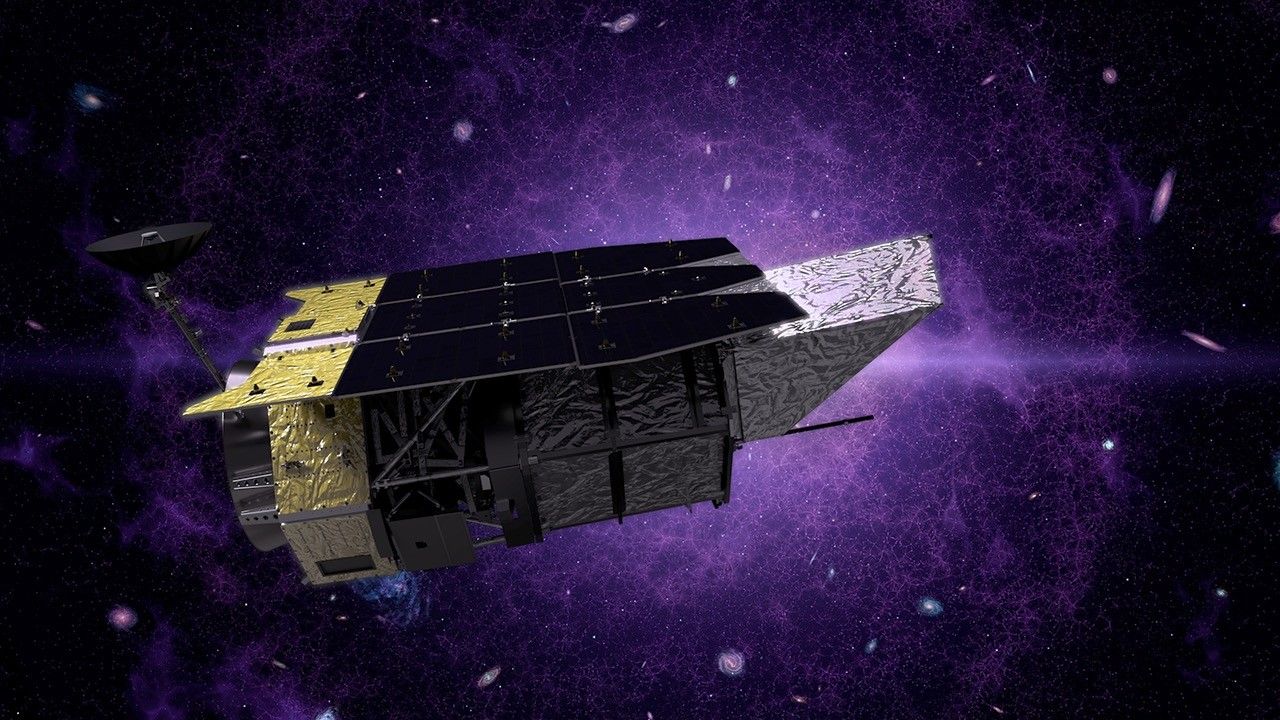
Lado Samushia, associate professor of physics , is part of a team designing a framework to evaluate data from the soon-to-be-launched Nancy Grace Roman Space Telescope, illustrated above, that could help answer some of the biggest questions about the fate of the universe.
The last question
Millions and billions of years from now, after explorers overcome the constraints of our solar system, after humankind — perhaps in another galaxy — breathes its final breath and after the last star’s fire fades, what will remain?
Astrophysicists and cosmologists don’t have sufficient data for a meaningful answer, at least not yet. But they’re hopeful that by looking into the past, they’ll gain insights into how the universe came to be, why it continues and accelerates in its expansion and what might become of the universe in a distant future when energy dissipates and the atoms that make up our planets, stars and galaxies are too far apart to matter.
Lado Samushia, associate professor of physics in the K-State College of Arts and Sciences, is part of an international team of cosmologists that is helping design the parameters for collecting and evaluating the data that will be returned by the Nancy Grace Roman Space Telescope, NASA’s next flagship mission to explore our universe, expected to launch by May 2027.
"One of the biggest questions in cosmology right now is why the universe’s expansion is accelerating,” Samushia said. “We know that the universe is expanding, and it’s getting bigger and bigger. Distances between distant objects are only becoming larger, and this expansion is accelerating, meaning its rate is increasing over time.
“With current physics, this is something that isn’t easy to explain, because if anything, you would expect the expansion to slow down because everything tends to clump together under gravity,” he said. “We observe the opposite of that, and it’s an unresolved problem in physics.”
“We, as humans, have this urge to know how things work. As children, we take toys and clocks apart. If that’s the attitude you have to life and science, then this is a very interesting question because it’s something we still don’t understand at the fundamental level.”
The Roman Space Telescope, Samushia said, will help give clues to answer that problem by surveying wide swaths of space to determine how galaxies are distributed in space. Researchers like Samushia will then develop statistical methods to measure any patterns in how those galaxies are clustered or spread apart to get a better understanding of the history of expansion in the universe.
The research will also help better explain how and why the universe’s expansion rate is accelerating, Samushia said, with dark energy widely believed to be the driving factor.
In the grand scheme of cosmology, or the study of the universe at the scale of billions of lightyears and millennia, there is little practical use to knowing the answers to these questions and problems that humanity can do nothing about.
But cosmology, like any other scientific discipline, is an innate reflection of humankind’s drive to believe, to know and to understand, Samushia said — to reach to and among the stars, through any difficulties.
It is humanity at its best.
“This is what science is about — figuring out how things work,” he said. “We, as humans, have this urge to know how things work. As children, we take toys and clocks apart. If that’s the attitude you have to life and science, then this is a very interesting question because it’s something we still don’t understand at the fundamental level.” ![]()
To study the rate of universe expansion from its furthest fringes, researchers need to use highly sensitive instruments that can detect the weak infrared light emitted by distant stars moving away from Earth.That’s why NASA is launching the Nancy Grace Roman Space Telescope, which will be equipped with the Wide Field Instrument to scan broad swaths of space for low-energy, tiny infrared particles.
Separately, the telescope’s Coronagraph Instrument will serve as “starglasses” to filter out individual stars’ light and reveal any potentially habitable planets hiding in their orbits.
Roman, like the James Webb Space Telescope, will orbit a point constantly in Earth’s shadow to protect it from the sun’s interference. Set to launch by 2027, it will have an expected mission lifetime of at least five years.
“Roman won’t be the biggest telescope in space, but it will be one of the most important for NASA as its next flagship mission to survey the sky,” Samushia said.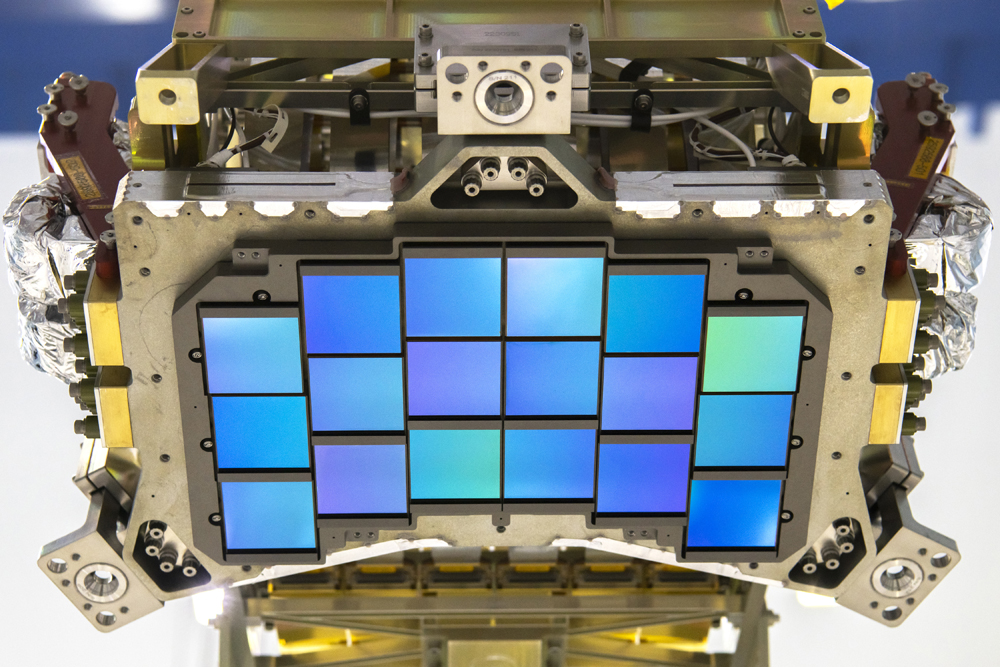
◊◊◊


